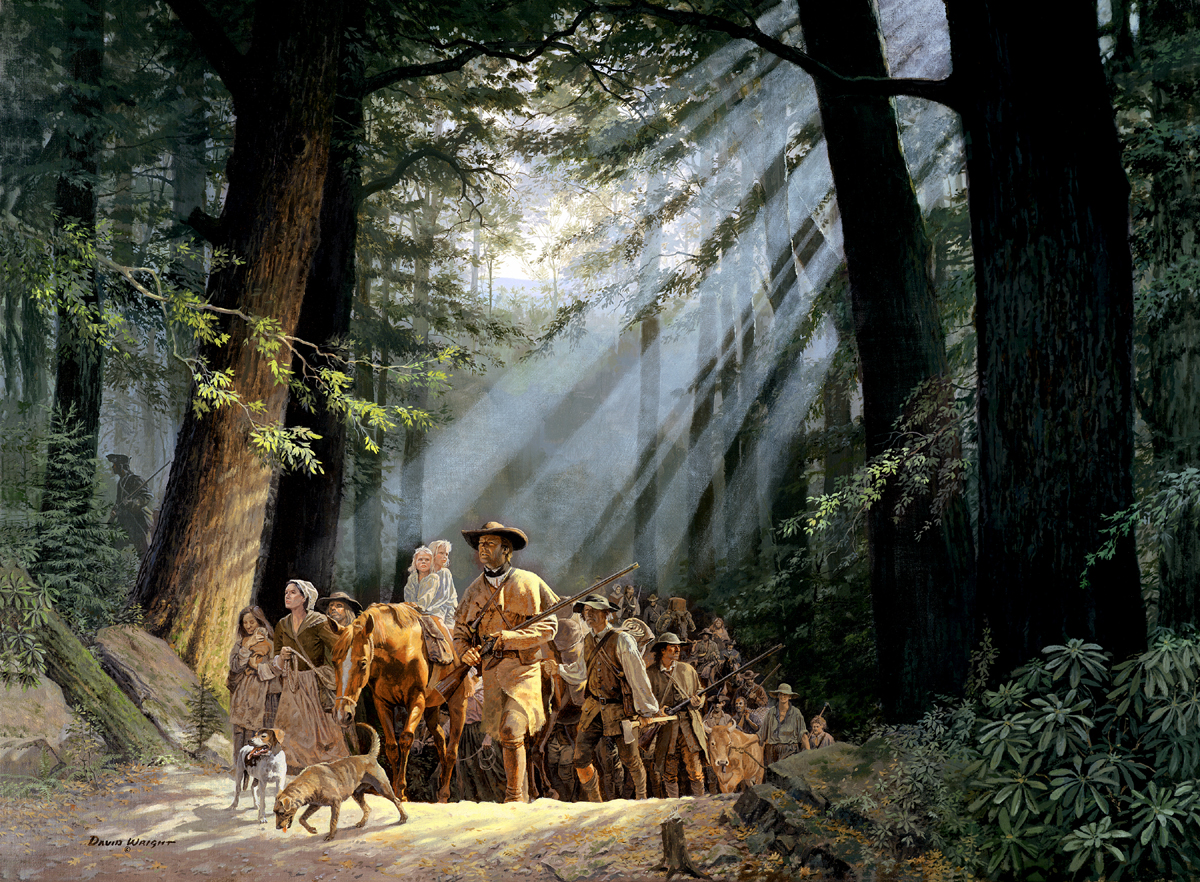19 - Abraham and Daniel Hiestand Settle in the "Carolinas"

Headed for "the Carolinas"
When the earliest post-Revolution settlers left their homes in places like Pennsylvania, Maryland, and Virginia and said, “We’re going to the Carolinas,” that did not necessarily mean they were going to the area enclosed in the current boundaries of North and South Carolina. There’s a good chance they may have been headed to Tennessee.*
The “Great Philadelphia Wagon Road” began in Philadelphia and ran westward through Lancaster, Pennsylvania across the Susquehanna River, through York, and Gettysburg, Pennsylvania. As the wagon road was running west it was gradually turning southward down into and through the Shenandoah Valley of western Maryland and Virginia. Near current-day Roanoke (then, called “Big Lick”) in southern Virginia, the road turned due south and entered North Carolina about 50 miles farther south. In the North Carolinian Piedmont, the road passed through the Moravian settlement of Salem, North Carolina, on past Salisbury and Charlotte, and then through South Carolina to Augusta, Georgia. As the Wagon Road passed Salem, it was about thirty miles west of where the city of Greensboro of Guilford County, North Carolina is today.
After Daniel Boone blazed a trail through upper-east Tennessee and into southern Kentucky, the “Wilderness Trail” became a well-traveled offshoot of the Great Wagon Road, leading pioneers into the great wilderness west of the Appalachian Mountains. “The opening of Tennessee and Kentucky deflected much of the former traffic of the Wagon Road”[i] as more and more settlers opted to go into the western wildernesses of North Carolina (Tennessee) and Virginia (Kentucky).
[i] Parke Rouse, Jr., From Philadelphia to the South: The Great Wagon Road. (Richmond, VA: The Dietz Press, 2001), 117.
Sometime prior to the autumn of 1783, Abraham and Daniel Hiestand must have announced to friends and family in Shenandoah County, Virginia that they were “going to the Carolinas,” because they were definitely preparing to go somewhere and both men showed up in western North Carolina shortly afterwards. When they came to the place where the Wilderness Road forked off of the Great Wagon Road, which way did they go? Did they both choose the same route? Or did they temporarily part ways?
Abraham had already purchased land in Tennessee, so he definitely had a reason to follow the Wilderness Road into the Washington District of Tennessee. But Daniel’s route is less certain. We will probably never know for sure, but there is some evidence that may suggest that Daniel continued to proceed south into the Piedmont of North Carolina and may have lingered there for a short time before crossing over the mountain into Tennessee.

Daniel's Three-Years Whereabouts
Daniel’s name and census-type information about his family appear on the 1783 Shenandoah County, Virginia tax list of Alexander Hite, but there is no specific date given for the tax listing census. Daniel may have lived in Shenandoah County until his father’s will was proven on August 28 of that year. But Daniel’s oldest brother Jacob sold (“released”) their father’s Fort Valley land—Daniel’s probable home place for ten years—on the very day their father’s will was proven in court. So, Daniel had already moved from Powell’s Fort Valley or was preparing to do so when Henrich Hiestand’s estate was settled.
The first date we know for sure that Daniel (Heston) was in the “Carolinas” was August 18, 1786 when he cast a vote in Jonesborough, Tennessee.[i] Where Daniel and his family were in the three years prior to August 1786 is unknown. He could have gone directly to Jonesborough or the area around there. Or he could have meandered in other parts of North Carolina before settling west of the Appalachian Range in eastern Tennessee. There are a few pieces of evidence that may warrant a hypothesis that he spent some time in Guilford County, North Carolina before moving westward over the mountain.
[i] Pollyanna Creekmore, “Documents Illustrative of Tennessee History,” Tennessee Ancestors, V, no. 2 (August 1989): 93.
Guilford County, North Carolina Connections

In a previous article, you saw that four men – “The Guilford County Four” – who were involved in the “Daniel Haston” Rev War military land grant, were from Guilford County, NC.
There were two other families who lived in Guilford County, NC who were known to have been connected to the Daniel Haston family. In a later article, you will learn about Philip & Mary McComisky Roddy AND James & Eleanor McComisky Ryan. The names “Roddy” and “McComiskey” were well-known to old-timer Haston researchers. But they searched in vain to figure out how these two surnames fit into the Daniel Haston family. It is just a guess on my part, but maybe Daniel spent a few months or a couple of years in Guilford County, NC before joining his brother, Abraham, over-the-mountain in Washington County, NC/TN. This Roddy-McComisky family and this Ryan-McComisky family also appear connected to the Hiestands/Hastons in Washington County–what is now Washington County, TN.
And in another later article, you will see that Daniel’s son, Joseph Haston, made a trip back to Guilford County, NC from Knoxville, TN in 1802, to settle an estate for Philip Roddy’s son, James Roddy. James Roddy, by the way, was (apparently) Daniel Haston’s son-in-law. But more on that story later also.
If you appreciated this article, please share it with others who might also enjoy it.

